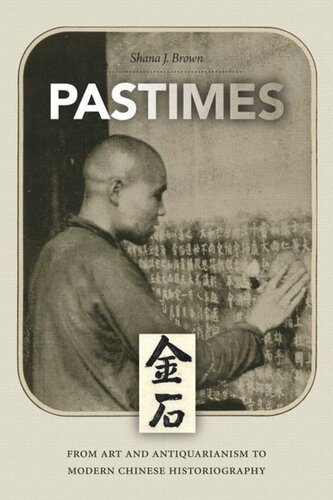

Most ebook files are in PDF format, so you can easily read them using various software such as Foxit Reader or directly on the Google Chrome browser.
Some ebook files are released by publishers in other formats such as .awz, .mobi, .epub, .fb2, etc. You may need to install specific software to read these formats on mobile/PC, such as Calibre.
Please read the tutorial at this link: https://ebookbell.com/faq
We offer FREE conversion to the popular formats you request; however, this may take some time. Therefore, right after payment, please email us, and we will try to provide the service as quickly as possible.
For some exceptional file formats or broken links (if any), please refrain from opening any disputes. Instead, email us first, and we will try to assist within a maximum of 6 hours.
EbookBell Team

4.3
28 reviewsPastimes is the first book in English on Chinese jinshi, or antiquarianism, the pinnacle of traditional connoisseurship of ancient artifacts and inscriptions. As a scholarly field, jinshi was inaugurated in the Northern Song (960–1127) and remained popular until the early twentieth century. Literally the study of inscriptions on bronze vessels and stone steles, jinshi combined calligraphy and painting, the collection of artifacts, and philological and historical research. For aficionados of Chinese art, the practices of jinshi offer a fascinating glimpse into the lives of traditional Chinese scholars and artists, who spent their days roaming the sometimes seamy world of the commercial art market before attending elegant antiquarian parties, where they composed poetic tributes to their ancient objects of obsession. And during times of political upheaval, such as the nineteenth century, the art and artifact studies of jinshi legitimatized reform and contributed to a dynamic and progressive field of learning.
Indeed, the paradox of jinshi is that it was nearly as venerable as the ancient artifacts themselves, and yet it was also subject to continual change. This was particularly true in the last decades of the Qing (1644–1911) and the first decades of the twentieth century, when a diverse group of cosmopolitan and science-minded scholars contributed to what was considered at the time to be a “revolution in traditional linguistics.” These antiquarians transformed how historians used literary sources and material artifacts from the ancient past and set the stage for a new understanding of the longevity and cohesiveness of Chinese history.
The history of jinshi offers insights that are relevant to Chinese cultural and intellectual history, art history, and politics. Scholars of the modern period will find the resiliency and continuing influence of jinshi to be an important counterpoint to received views on the trajectory of Chinese cultural and intellectual change. We are accustomed to think that Chinese modernity originated in the great tumult of the turn-of-the-century encounter with foreign learning. The example of jinshi reveals the significance of local transformations that occurred much earlier in the nineteenth century. Its combination of art and historiography reveals the full range of scholarly appreciation for the past and its artifacts and provides a unique perspective from which to define “modern China” and illuminate its indigenous origins.